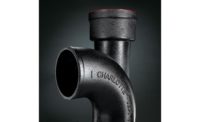
Cast iron soil pipes and fittings are manufactured to be tough. Products are made using a unique process that involves pouring molten or liquid iron into a mold to shape into pipes or fittings. Finished products are used in drain, waste, and vent (DWV) applications. The quality of cast iron soil pipes and fittings are kept in check by solid national standards and specifications.
There are three major standards for cast iron soil pipe and fittings in the US:
ASTM A888–Hubless Cast Iron Soil Pipe and Fittings for Sanitary and Storm Drain, Waste, and Vent Piping Applications
CISPI 301–Hubless Cast Iron Soil Pipe and Fittings for Sanitary and Storm Drain, Waste, and Vent Applications
ASTM A74–Cast Iron Soil Pipe and Fittings
Each standard has similar requirements for materials, manufacturing, coating, marking, dimensions, mechanical and chemical testing, sampling, and certification.
Mechanical testing ensures the tensile strength of test bars is not less than 21,000 psi at the time of production. Chemical test results must meet specific composition requirements for phosphorous, sulfur, chromium, titanium, aluminum, lead, and carbon equivalent at the time of production. Dimensions of pipes and fittings must meet several requirements within the tables of the standards.
Recently, both ASTM A888 and ASTM A74 were revised to include a mandatory annex regarding third-party certification or inspection. This new annex includes additional specifications for situations where manufacturers employ third-party certifiers, or inspectors as a part of their own certification to the standards.
The annex stipulates that, when conducting foundry inspections, third-party certifiers or inspectors must add two items to their scope:
1]A review of the manufacturer’s records to verify compliance to the quality control requirements within the standards. This includes confirming that manufacturers are screening scrap iron for radioactivity, performing mechanical and chemical testing to determine the mechanical properties of the gray iron, and inspecting the dimensions of the finished product against the standards requirements. Documentation proving these take place at the required frequencies are required to be added to the certifier’s or inspector’s report.
2]A dimensional and marking inspection of the manufacturer’s finished product.The standards now require a minimum of 10 randomly selected pipes and 10 randomly selected fittings be inspected for appropriate dimensions and markings. Pipes must be different sizes and fittings shall be different sizes or configurations or both. Inspection results are required to be included with manufacturers own testing reports, which are mandatory in the self-certification sections of the standards.
The additional requirements to ASTM A74 and ASTM A888 strengthen the already rigorous quality control standard specifications. By obtaining third-party certification, manufacturers can ensure their products meet these standards and can demonstrate compliance to purchasers, design professionals or regulatory authorities.
